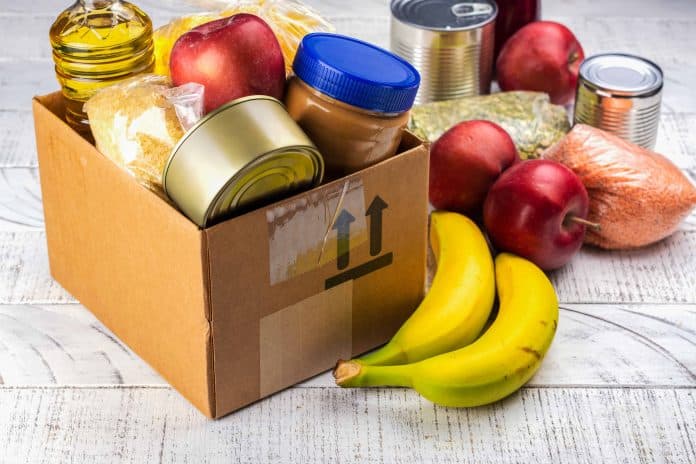
The cost of groceries can be an especially challenging expense. Budgeting and planning for your entire family can be difficult, with everyone having different wants and needs. When you add financial stress on top of it, shopping for food for your family can become what feels like an impossible task.
The last few years have been particularly difficult when it comes to handling the cost of groceries. If you’re having a hard time keeping your home stocked with nutritious foods, then you may be able to benefit from government nutrition assistance. There are various programs that the federal government offers. Specifically, the United States Department of Agriculture (USDA) funds initiatives that aim to increase access to healthy foods for low-income households. When it comes to getting the help you need, a good first step is understanding what’s available!
Which Food Assistance Programs Should You Consider?
If you’re struggling with the cost of groceries, you certainly are not alone. In fact, the cost of food is up 5% from March 2022 to March 2023. As a result, you may have found yourself needing to go over budget when it comes to grocery costs. If going over budget isn’t an option because you don’t have the extra income to spare, then you can find yourself in a tough position. Fortunately, there are nutrition programs designed to help families like yours afford healthy foods. Moreover, some programs may even be able to help you expand your grocery budget by offering regular funds. If you’re in need of food assistance, you can consider one or more of the following programs:
- The Emergency Food Assistance Program (TEFAP)
- Child and Adult Care Food Program (CACFP)
- School Breakfast Program (SBP)
- Special Milk Program (SMP)
- Supplemental Nutrition Assistance Program (SNAP)
- Special Supplemental Nutrition Program for Women, Infants, and Children (WIC)
- Farmers Market Nutrition Program (FMNP)
- Commodity Supplemental Food Program (CSFP)
- Senior Farmers’ Market Nutrition Program (SFMNP)
The Emergency Food Assistance Program (TEFAP)
TEFAP provides emergency food assistance to people in need at no cost to them. This federal program helps low-income households gain access to nutritious foods during tough times. TEFAP works with the help of multiple parties. State distributing agencies, such as food banks, are given an allotment of nutritious USDA foods. The USDA makes regular purchases of these food items in bulk in order to send them out to state agencies. Every state that takes part in this program doesn’t receive the same amount of food. The program considers factors, such as the poverty and unemployment rates within the state. This helps the USDA determine how much of a need the people within each state have for this assistance.
People in need can benefit from TEFAP directly through local organizations. Examples of these places are soup kitchens, food pantries, community action agencies, etc. These local organizations pick up the bulk items that they are going to serve from the food banks. TEFAP isn’t meant to complete a person’s diet. Instead, individuals can get support at times when they really need it. If you would like more information about this, you can find the contact information of your state’s distributing agency on the FNS website. They will be able to provide you with the best answers!
Child And Adult Care Food Program (CACFP)
Over 3 million children and 100,000 adults benefit from food reimbursed by CACFP each day! This federal program reimburses child and adult daycare centers for the nutritious meals and snacks that they offer to individuals in their care. In addition to these facilities, qualifying after-school programs and emergency shelters can also take part in this program.
School Breakfast Program (SBP)
The School Breakfast Program (SBP) helps students of low-income families start their day on a positive note by eating a nutritious breakfast. SBP offers free or reduced-priced breakfasts to qualifying students while in school. In order to qualify for SBP, the student’s household needs to meet certain income guidelines. The income guidelines are different for free breakfast compared to the reduced-cost option. In addition to that, students may also be eligible if one of the following is true:
- They are foster children.
- Their household is already benefiting from another federal program, such as SNAP or Head Start.
- They are experiencing homelessness.
- They are either runaways or migrants.
The Food and Nutrition Service (FNS) provides this meal program! With that in mind, state agencies are responsible for operating the program. Therefore, participating facilities can expect to work directly with these agencies rather than the federal government. Examples of facilities that are able to run SBP include public schools, non-profit private schools, and certain childcare centers. Facilities that serve free or reduced-cost breakfasts with SBP can receive cash subsidies as reimbursements.
Special Milk Program (SMP)
SMP provides free milk to qualifying children at school. Families who don’t already benefit from other federal child nutrition programs may be eligible for SMP. With nutrition in mind, the program specifies both the type and quality of milk that can be offered to students. For example, the Food and Drug Administration (FDA) determines the levels of Vitamin A and Vitamin D that the milk must have. Not only that, the milk must be pasteurized as well as low-fat or fat-free. In addition to those requirements, the quality must also satisfy state and local requirements. Places like schools, certain camps, and childcare facilities participate in this program. The program pays them back by reimbursing them for the milk they serve to children.
Supplemental Nutrition Assistance Program (SNAP)
Recipients of this popular food assistance program can benefit from monthly funds meant to assist with the cost of groceries. The Supplemental Nutrition Assistance Program (SNAP) was widely referred to as food stamps. Now, people use Electronic Benefit Transfer (EBT) cards to pay. Prior to EBT cards, food stamps were the primary way that benefits were distributed. Back in 2004, SNAP began using EBT cards to allow households to easily access and spend their monthly funds.
Approved participants of SNAP are issued an EBT card. They can use their funds to purchase qualifying food items and stores that accept this form of payment. This food assistance option is available to households that qualify based on a few factors. One major factor is a household’s income level. Besides that, specific eligibility depends on which state an applicant is applying to. If you’re interested in benefiting from this program, you can visit their website online or speak to someone over the phone!
Types of Food Items Covered by the Program
As stated previously, recipients of SNAP can only spend their benefits on qualifying food items. Below is a list of foods that are approved for purchase using EBT:
- Fruits and vegetables
- Meat, poultry, and fish
- Dairy products
- Bread and cereals
- Canned goods
While there are plenty of food items that can be bought with SNAP benefits, it’s important to keep in mind that there are certain items that do not qualify. For example, alcohol, tobacco, hot prepared meals, and non-food items cannot be bought using EBT.
Special Supplemental Nutrition Program for Women, Infants, and Children (WIC)
The Special Supplemental Nutrition Program for Women, Infants, and Children (WIC) is another food assistance program that can provide monthly benefits. However, there are big differences between WIC and the previous program we listed, which was SNAP. First, the largest difference may be the limited demographic that is able to benefit from this assistance. Those who can benefit include pregnant women, breastfeeding mothers, new mothers, infants less than one-year-old, and children aged five years and under. Second, there are additional benefits that WIC offers outside of monthly food cost assistance. WIC recipients can also benefit from nutrition education, as well as healthcare and other referrals to services.
WIC is also offered by the Food and Nutrition Service (FNS). This program operates on a large scale all across the United States. There are 1,900 agencies, as well as 10,000 clinic sites that recipients can turn to! In addition to that, about 47,000 retailers are authorized to operate. If you are interested in benefiting from this assistance, you can reach out to your local or state WIC agency to get started.
Farmers Market Nutrition Program (FMNP)
Women and children that qualify for WIC are also eligible to receive additional benefits with FMNP. However, there are some exceptions. Babies younger than four months old can not benefit from this program. The assistance is delivered in the form of coupons to use towards certain food items. They can be used to purchase food from farmer’s markets, and roadside stands, as well as directly from farmers. In addition to that, it’s important to know that these businesses need approval in order to accept FMNP coupons. The program operates from grants that states receive from the Food and Nutrition Service (FNS). If you are interested in getting more information about this program, your state WIC FMNP Agency is the best place to turn to. Their contact information can be found online.
Commodity Supplemental Food Program (CSFP)
The Commodity Supplemental Food Program (CSFP) helps supplement the diets of qualifying seniors with nutritious foods. The assistance typically comes in the form of food packages and is distributed directly to those in need by local organizations. These local organizations can either be public or nonprofit and private.
CSFP helps recipients maintain a balanced diet without breaking the bank. Those who can benefit from this program won’t receive a sufficient amount of food to complete their entire diet. Instead, these food packages are meant to make up for important nutrients that the recipient may not be getting enough of. The USDA offers this program by allocating both food and funds to states and Indian Tribal Organizations (ITOs).
Who Qualifies for CSFP?
To be eligible for CSFP, individuals need to satisfy certain criteria. One of the main requirements of this program is the age requirement. This program is only intended for elderly individuals. With that being said, the following qualifications are mandatory in order to receive assistance from CSFP:
- Being at least 60 years old or older
- Falling within specific income guidelines set by each state or local agency
- Living in an area where CSFP operates
You can find more information about this program by contacting the CSFP state agency closest to you.
Senior Farmers’ Market Nutrition Program (SFMNP)
The Senior Farmers’ Market Nutrition Program (SFMNP) is yet another program intended to help individuals with the cost of food, but be aware all may not qualify. The SFMNP looks to help qualifying seniors get access to fresh, locally grown produce. The minimum age requirement for this program is also 60 years old. Furthermore, in order to qualify, there are income limits. These individuals should not make an income that is greater than 185% of the federal poverty guidelines.
The food assistance that qualifying individuals can receive is offered via vouchers. These vouchers can be traded for fruits, vegetables, herbs, honey, and more at participating farmers’ markets. SFMNP not only promotes a healthy diet among seniors but also supports local agricultural communities.
In Closing
To sum up, there are many forms of food assistance that both families and individuals can access during times of need. These various nutrition support programs exist for people with limited funds. Moreover, they can help people who otherwise don’t have regular access to healthy and nourishing food choices. When deciding on which program is best suited for your needs, you can consider your personal situation. Do you struggle to afford the extra costs for your child to eat at school? Or would you benefit more from monthly funds to use towards food items at the store? Whatever type of assistance you’re in need of, it’s important to take action as soon as possible! You and your family deserve to have enough healthy food to eat!


















